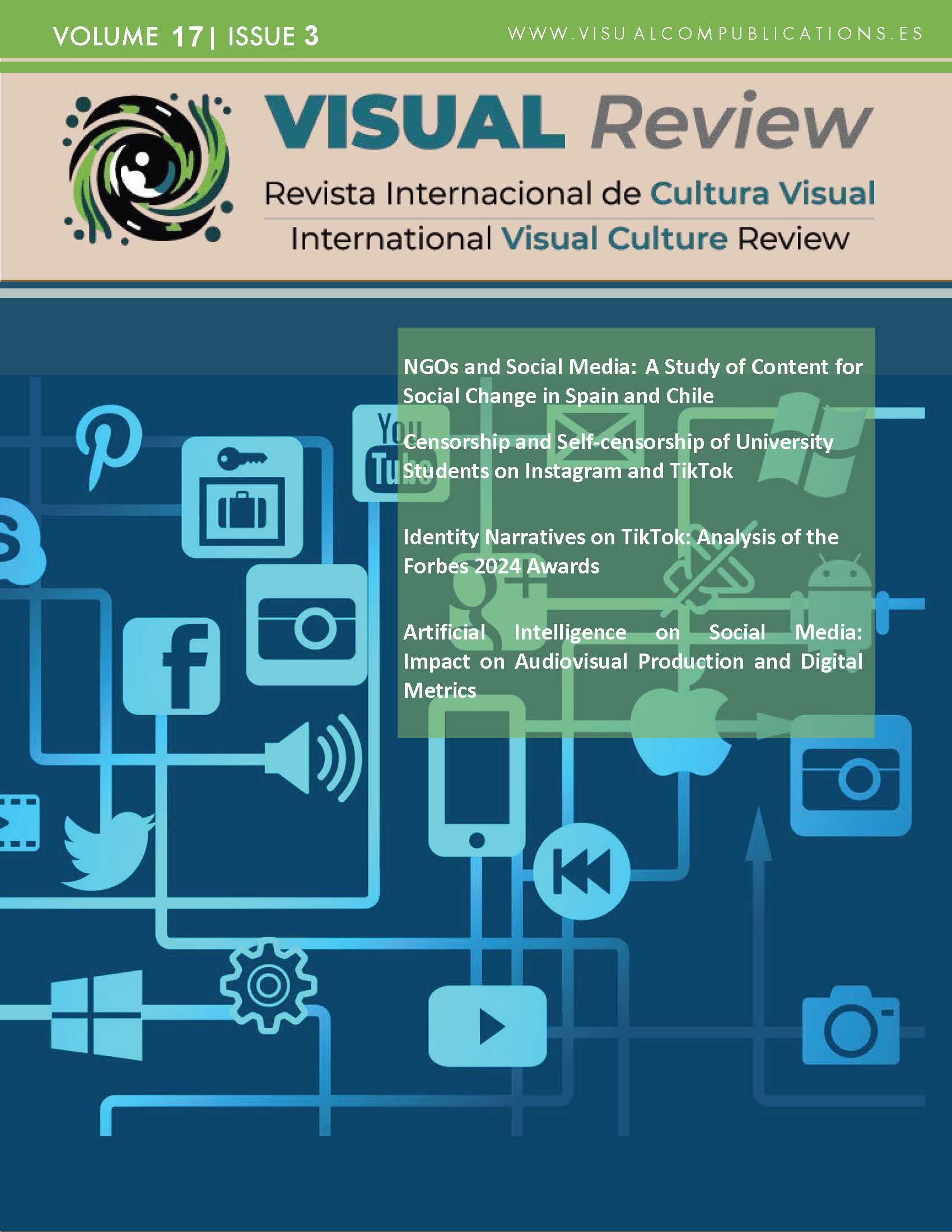Patrones Lingüísticos y Visuales de ChatGPT en la Educación Superior
Un Análisis de su Uso en Tesis de Grado
DOI:
https://doi.org/10.62161/revvisual.v17.5403Palabras clave:
Patrones lingüísticos, Estilo de escritura, Educación superior, Integridad académica, ChatGPT, Inteligencia artificial, Tecnología educativaResumen
Este artículo examina la influencia de la inteligencia artificial en la redacción académica, enfocándose en las tesis de grado. Su objetivo es identificar los patrones lingüísticos y visuales en textos generados o asistidos por ChatGPT, mediante un análisis de 50 tesis de pregrado y maestría, distribuidas equitativamente entre una universidad pública y una privada de Perú. Los resultados indican que las estructuras argumentativas más representativas incluyen términos como “además”, “papel crucial” y “exhaustiva”. Se observó un 48% de similitud argumentativa en la universidad pública, en contraste con el 72% en la universidad privada. Se recomienda ampliar el análisis con otros modelos de lenguaje, como BART.
Descargas
Estadísticas globales ℹ️
|
610
Visualizaciones
|
323
Descargas
|
|
933
Total
|
|
Citas
Acosta-Enriquez, B. G., Arbulú Pérez Vargas, C. G., Huamaní Jordan, O., Arbulú Ballesteros, M. A., & Paredes Morales, A. E. (2024). Exploring attitudes toward ChatGPT among college students: An empirical analysis of cognitive, affective, and behavioral components using path analysis. Computers and Education: Artificial Intelligence, 7, 100320. https://doi.org/10.1016/j.caeai.2024.100320 DOI: https://doi.org/10.1016/j.caeai.2024.100320
Al Murshidi, G., Shulgina, G., Kapuza, A., & Costley, J. (2024). How understanding the limitations and risks of using ChatGPT can contribute to willingness to use. Smart Learning Environments, 11(1), 36. https://doi.org/10.1186/s40561-024-00322-9 DOI: https://doi.org/10.1186/s40561-024-00322-9
Baek, C., Tate, T., & Warschauer, M. (2024). “ChatGPT seems too good to be true”: College students’ use and perceptions of generative AI. Computers and Education: Artificial Intelligence, 7, 100294. https://doi.org/10.1016/j.caeai.2024.100294 DOI: https://doi.org/10.1016/j.caeai.2024.100294
Dąbrowska, E. (2020). How Writing Changes Language. In Language Change: The Impact of English as a Lingua Franca (pp. 75–94). Cambridge University Press. https://doi.org/10.1017/9781108675000.006 DOI: https://doi.org/10.1017/9781108675000.006
Difabio de Anglat, H., & Álvarez, G. (2022). Las conclusiones de la tesis doctoral en educación: sus movimientos y pasos retóricos. Areté, Revista Digital Del Doctorado En Educación, 8(16), 11–36. https://doi.org/10.55560/ARETE.2022.16.8.1 DOI: https://doi.org/10.55560/ARETE.2022.16.8.1
Gruenhagen, J. H., Sinclair, P. M., Carroll, J. A., Baker, P. R. A., Wilson, A., & Demant, D. (2024). The rapid rise of generative AI and its implications for academic integrity: Students’ perceptions and use of chatbots for assistance with assessments. Computers and Education: Artificial Intelligence, 7, 100273. https://doi.org/10.1016/j.caeai.2024.100273 DOI: https://doi.org/10.1016/j.caeai.2024.100273
Guentulle, V., Nussbaum, M., Castillo, F., Chiuminatto, P., Spector, J. M., & Rojas, M. (2024). The relationship between creativity and language as measured by linguistic maturity and text production. Thinking Skills and Creativity, 54, 101636. https://doi.org/10.1016/j.tsc.2024.101636 DOI: https://doi.org/10.1016/j.tsc.2024.101636
Gunser, V. E., Gottschling, S., Brucker, B., Richter, S., Çakir, D. C., & Gerjets, P. (2022). The Pure Poet: How Good is the Subjective Credibility and Stylistic Quality of Literary Short Texts Written with an Artificial Intelligence Tool as Compared to Texts Written by Human Authors? Proceedings of the 44th Annual Meeting of the Cognitive Science Society: Cognitive Diversity, CogSci 2022, 1744–1750. https://www.scopus.com/inward/record.uri?eid=2-s2.0-85140344936&partnerID=40&md5=9b5cf2bcff5a7c1412231df0dac08974
Guo, J., Chen, Z., & Zheng, B. (2021). Postgraduate Competence and Academic Research Performance: The Mediating Role of Psychological Capital. Sustainability, 13(11). https://doi.org/10.3390/su13116469 DOI: https://doi.org/10.3390/su13116469
Hayhoe, R., & Zha, Q. (2005). The Role of Public Universities in the Move to Mass Higher Education: Some Reflections on the Experience of Taiwan, Hong Kong, and China. In Taking Public Universities Seriously (pp. 5–25). University of Toronto Press. http://www.jstor.org/stable/10.3138/9781442680333.4 DOI: https://doi.org/10.3138/9781442680333-002
Jo, H. (2024). From concerns to benefits: a comprehensive study of ChatGPT usage in education. International Journal of Educational Technology in Higher Education, 21(1), 35. https://doi.org/10.1186/s41239-024-00471-4 DOI: https://doi.org/10.1186/s41239-024-00471-4
Kim, E. (2017). Workshop design for enhancing the appropriateness of idea generation using analogical thinking. International Journal of Innovation Studies, 1(2), 134–143. https://doi.org/10.1016/j.ijis.2017.10.002 DOI: https://doi.org/10.1016/j.ijis.2017.10.002
Kiraka, R. (2020). University reputation management. In Strategic Marketing of Higher Education in Africa (pp. 159–175). Taylor and Francis. https://doi.org/10.4324/9780429320934-12 DOI: https://doi.org/10.4324/9780429320934-12
Lee, S., & Song, K. S. (2024). Teachers’ and students’ perceptions of AI-generated concept explanations: Implications for integrating generative AI in computer science education. Computers and Education: Artificial Intelligence, 7, 100283. https://doi.org/10.1016/j.caeai.2024.100283 DOI: https://doi.org/10.1016/j.caeai.2024.100283
Lee, V. R., Pope, D., Miles, S., & Zárate, R. C. (2024). Cheating in the age of generative AI: A high school survey study of cheating behaviors before and after the release of ChatGPT. Computers and Education: Artificial Intelligence, 7, 100253. https://doi.org/10.1016/j.caeai.2024.100253 DOI: https://doi.org/10.1016/j.caeai.2024.100253
Mateo, J. F. (2022). ARTIFICIAL REALITY Exploring the Potential Threats of Artificial Intelligence. VISUAL Review. International Visual Culture Review / Revista Internacional de Cultura , 9(2), 235–247. https://doi.org/10.37467/revvisual.v9.5004 DOI: https://doi.org/10.37467/revvisual.v9.5004
Naithani, K., Raiwani, Y. P., & Sissodia, R. (2022). Text-Based Analysis of COVID-19 Comments Using Natural Language Processing. In D. A., A. S.S., & S. A. (Eds.), Communications in Computer and Information Science: Vol. 1546 CCIS (pp. 195–209). Springer Science and Business Media Deutschland GmbH. https://doi.org/10.1007/978-3-030-95711-7_17 DOI: https://doi.org/10.1007/978-3-030-95711-7_17
Peña-Cáceres, O., Rea, M. G. B., Silva-Marchan, H., Espinoza-Nima, R., Yánez-Palacios, J., & Garay-Silupu, E. (2025). Using Google Maps as a Tool for Two-Way Political Communication with Citizens: Analysis of the Case of the Congress of the Republic of Peru. VISUAL REVIEW. International Visual Culture Review / Revista Internacional de Cultura Visual, 17(1), 149–163. https://doi.org/10.62161/REVVISUAL.V17.5342 DOI: https://doi.org/10.62161/revvisual.v17.5342
Putra, F. W., Rangka, I. B., Aminah, S., & Aditama, M. H. R. (2023). ChatGPT in the higher education environment: Perspectives from the theory of high order thinking skills. Journal of Public Health (United Kingdom), 45(4), e840–e841. https://doi.org/10.1093/pubmed/fdad120 DOI: https://doi.org/10.1093/pubmed/fdad120
Shahzad, M. F., Xu, S., & Javed, I. (2024). ChatGPT awareness, acceptance, and adoption in higher education: the role of trust as a cornerstone. International Journal of Educational Technology in Higher Education, 21(1), 46. https://doi.org/10.1186/s41239-024-00478-x DOI: https://doi.org/10.1186/s41239-024-00478-x
Soria, G. M. L. (2023). La introducción de un artículo científico. Gaceta Médica Boliviana, 46(1), 5–5. https://doi.org/10.47993/GMB.V46I1.611 DOI: https://doi.org/10.47993/gmb.v46i1.611
Sun, Y., Sheng, D., Zhou, Z., & Wu, Y. (2024). AI hallucination: towards a comprehensive classification of distorted information in artificial intelligence-generated content. Humanities and Social Sciences Communications, 11(1), 1278. https://doi.org/10.1057/s41599-024-03811-x DOI: https://doi.org/10.1057/s41599-024-03811-x
Suriano, R., Plebe, A., Acciai, A., & Fabio, R. A. (2025). Student interaction with ChatGPT can promote complex critical thinking skills. Learning and Instruction, 95, 102011. https://doi.org/10.1016/j.learninstruc.2024.102011 DOI: https://doi.org/10.1016/j.learninstruc.2024.102011
Vialart, V. N., Rodríguez López, E. I., Véliz Martínez, P. L., Suárez Cabrera, A., Morales Cordovés, E., Zelada Pérez, M. de los M., & Pérez Morales, K. (2016). Tendencias actuales de programas de estudio de pregrado y posgrado con orientación a la Atención Primaria de la Salud. Educación Médica Superior, 30, 615–626. http://scielo.sld.cu/scielo.php?script=sci_arttext&pid=S0864-21412016000300015&nrm=iso
Vieno, K., Rogers, K. A., & Campbell, N. (2022). Broadening the Definition of “Research Skills” to Enhance Students’ Competence across Undergraduate and Master’s Programs. Education Sciences, 12(10). https://doi.org/10.3390/educsci12100642 DOI: https://doi.org/10.3390/educsci12100642
Weng, X., Xia, Q., Ahmad, Z., & Chiu, T. K. F. (2024). Personality traits for self-regulated learning with generative artificial intelligence: The case of ChatGPT. Computers and Education: Artificial Intelligence, 7, 100315. https://doi.org/10.1016/j.caeai.2024.100315 DOI: https://doi.org/10.1016/j.caeai.2024.100315
Williams, A. (2024). Comparison of generative AI performance on undergraduate and postgraduate written assessments in the biomedical sciences. International Journal of Educational Technology in Higher Education, 21(1), 52. https://doi.org/10.1186/s41239-024-00485-y DOI: https://doi.org/10.1186/s41239-024-00485-y
Xu, Y., Gábor, K., Khouas, L., & Segond, F. (2022). Prompt Engineering-Based Text Anomaly Detection. In E. Y., J. T., P. T., & B. M.Z. (Eds.), Traitement Automatique des Langues Naturelles, TALN 2022 - Actes de la 29e Conference sur le Traitement Automatique des Langues Naturelles: Conference Principale (Vol. 1, pp. 42–53). Association pour le traitement automatique des langues. https://www.scopus.com/inward/record.uri?eid=2-s2.0-85175856968&partnerID=40&md5=ad784ff5d1617b9b7a7c4b0d00fa46be
Descargas
Publicado
Cómo citar
Número
Sección
Licencia
Derechos de autor 2025 Los autores/as conservan los derechos de autor y ceden a la revista el derecho de la primera publicación y el derecho de edición

Esta obra está bajo una licencia internacional Creative Commons Atribución-SinDerivadas 4.0.
Los autores/as que publiquen en esta revista aceptan las siguientes condiciones:
- Los autores/as conservan los derechos de autor.
- Los autores/as ceden a la revista el derecho de la primera publicación. La revista también posee los derechos de edición.
- Todos los contenidos publicados se regulan mediante una Licencia Atribución/Reconocimiento-SinDerivados 4.0 Internacional. Acceda a la versión informativa y texto legal de la licencia. En virtud de ello, se permite a terceros utilizar lo publicado siempre que mencionen la autoría del trabajo y a la primera publicación en esta revista. Si transforma el material, no podrá distribuir el trabajo modificado.
- Los autores/as pueden realizar otros acuerdos contractuales independientes y adicionales para la distribución no exclusiva de la versión del artículo publicado en esta revista (p. ej., incluirlo en un repositorio institucional o publicarlo en un libro) siempre que indiquen claramente que el trabajo se publicó por primera vez en esta revista.
- Se permite y recomienda a los autores/as a publicar su trabajo en Internet (por ejemplo en páginas institucionales o personales), una vez publicado en la revista y citando a la misma ya que puede conducir a intercambios productivos y a una mayor y más rápida difusión del trabajo publicado (vea The Effect of Open Access).













